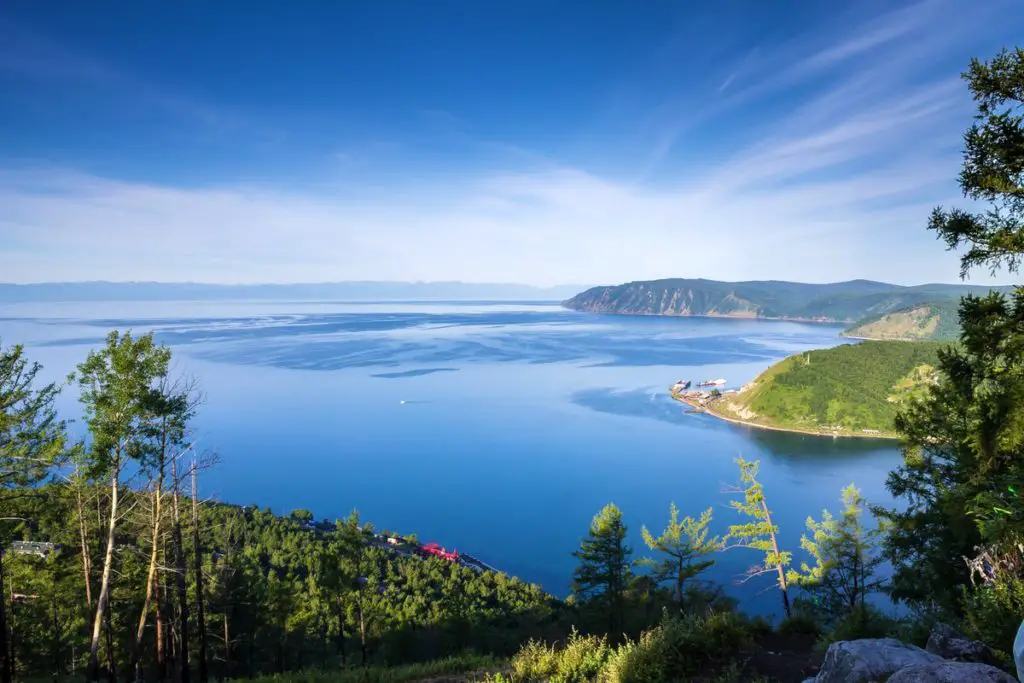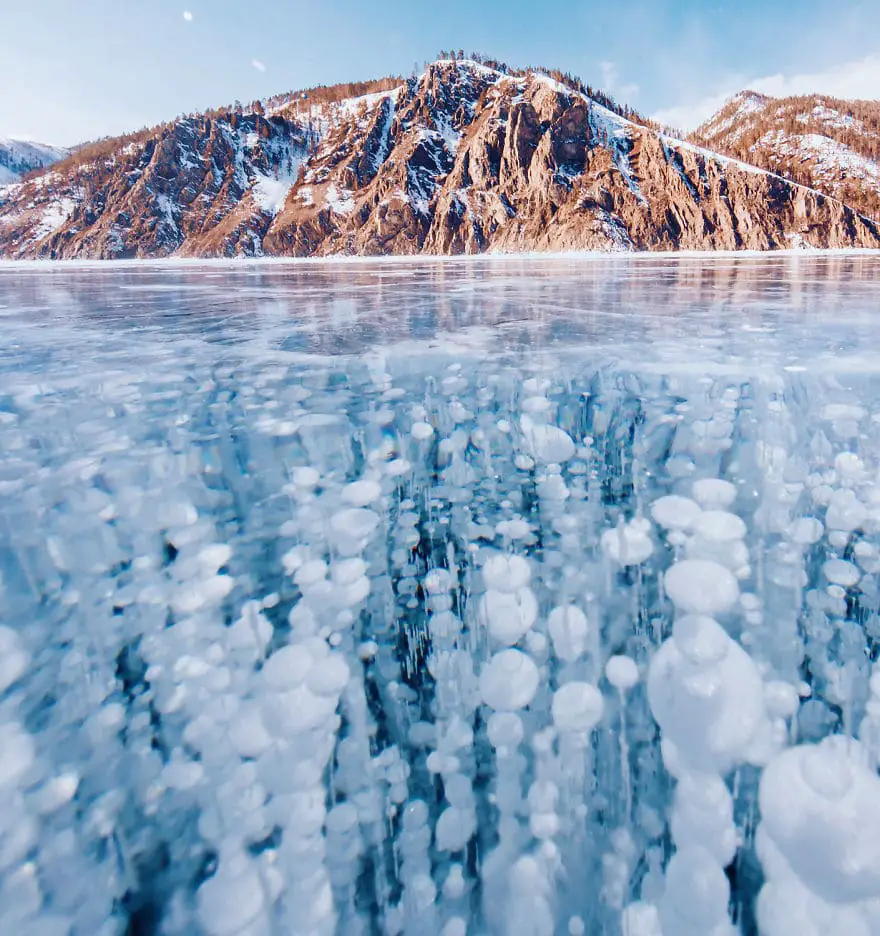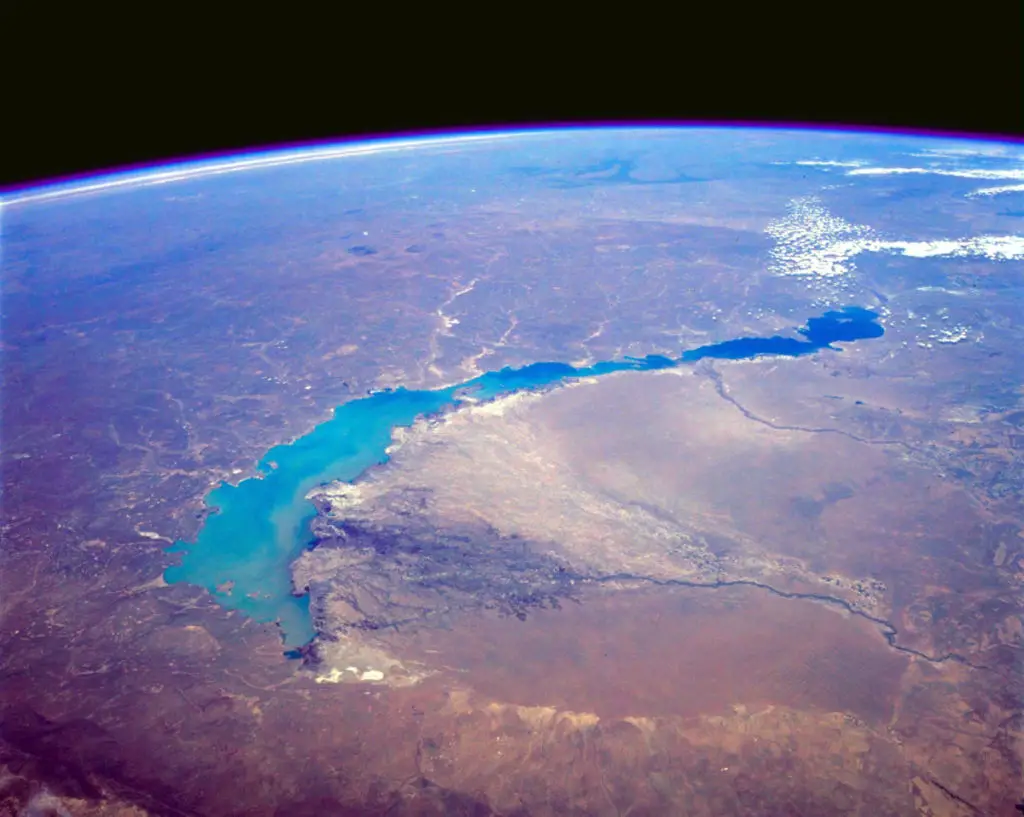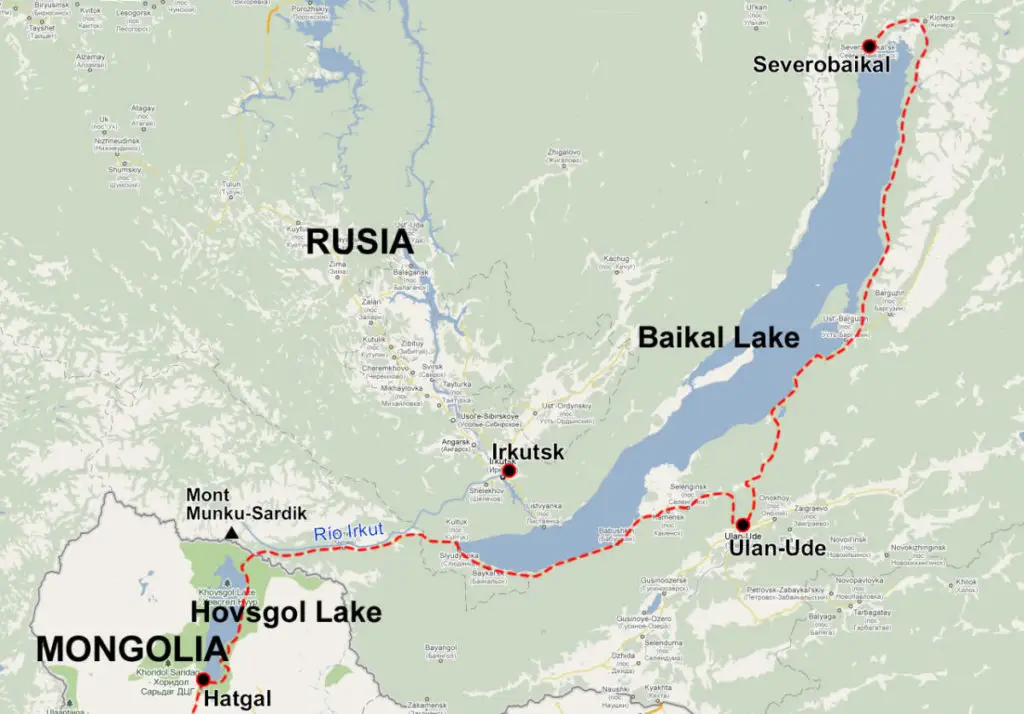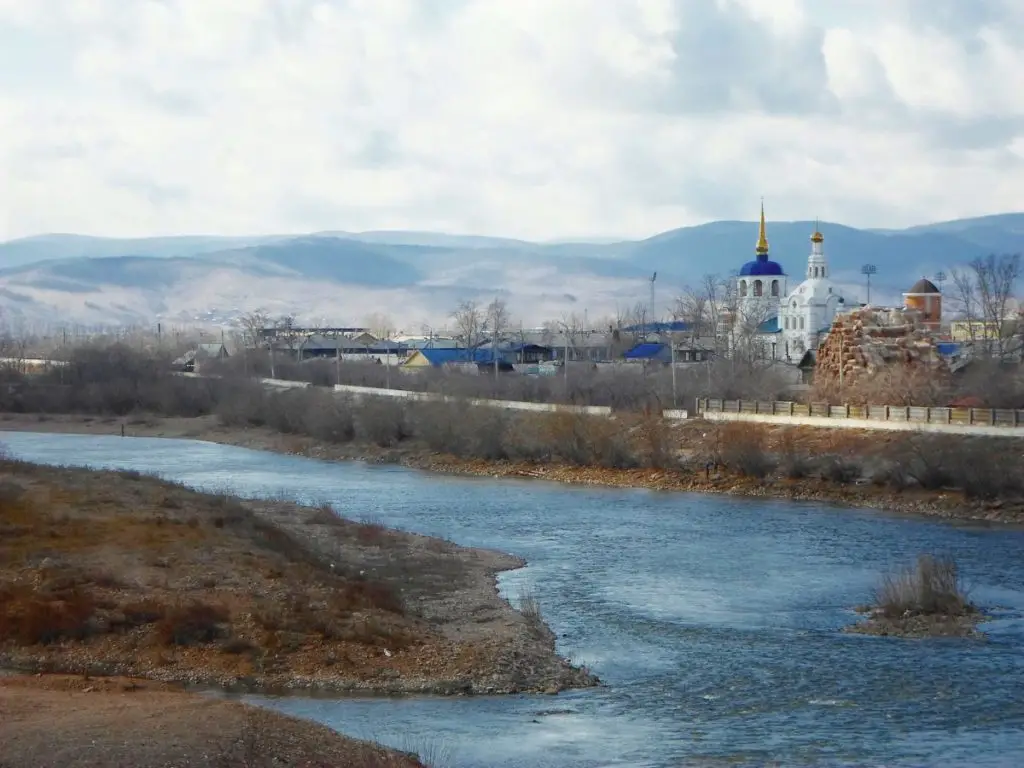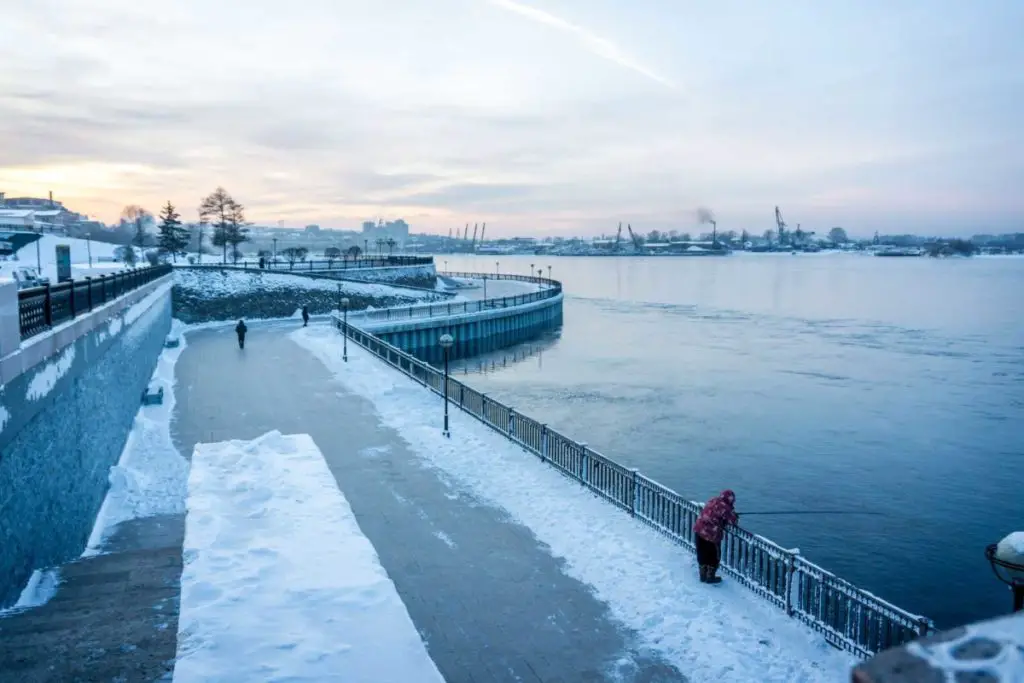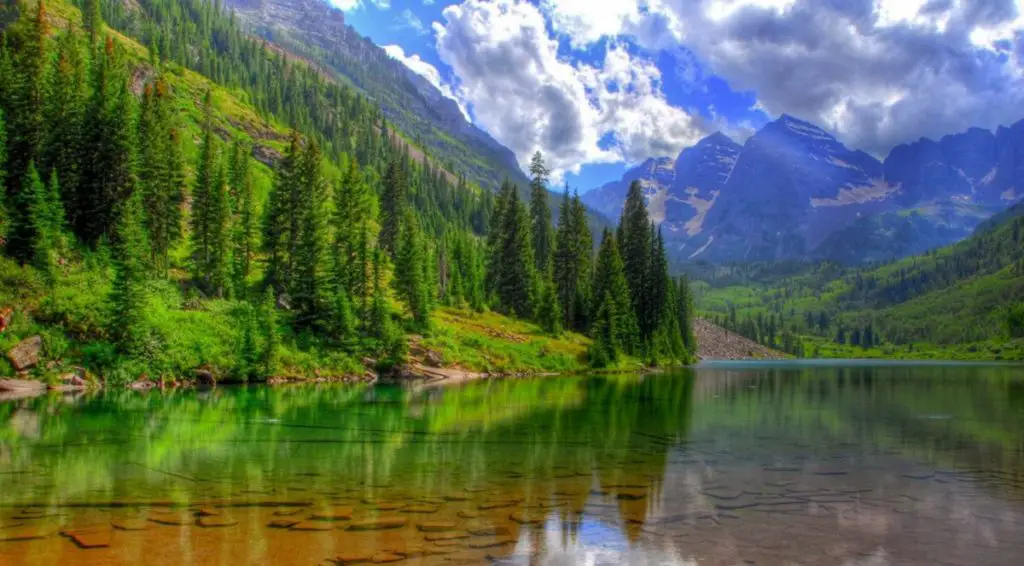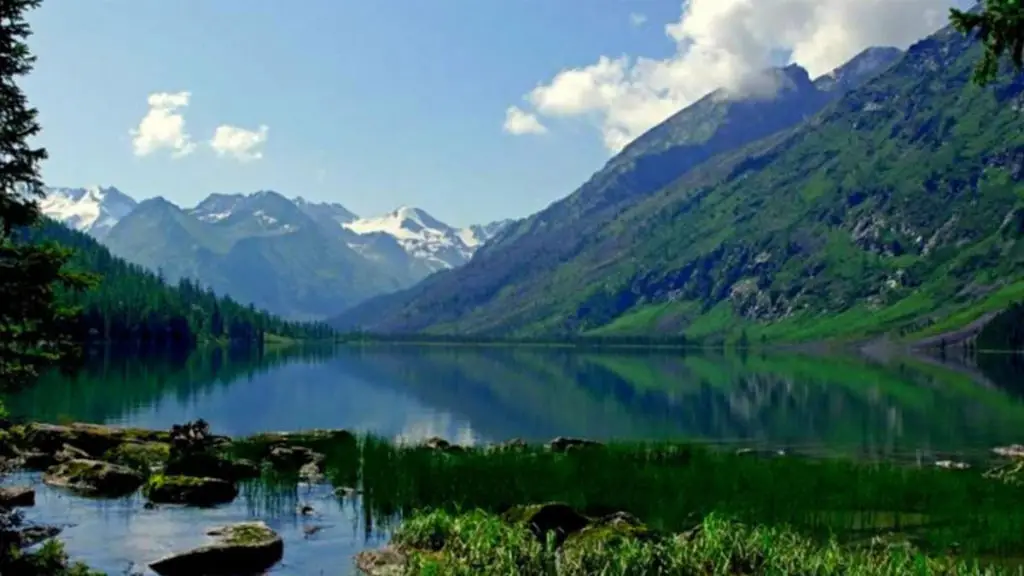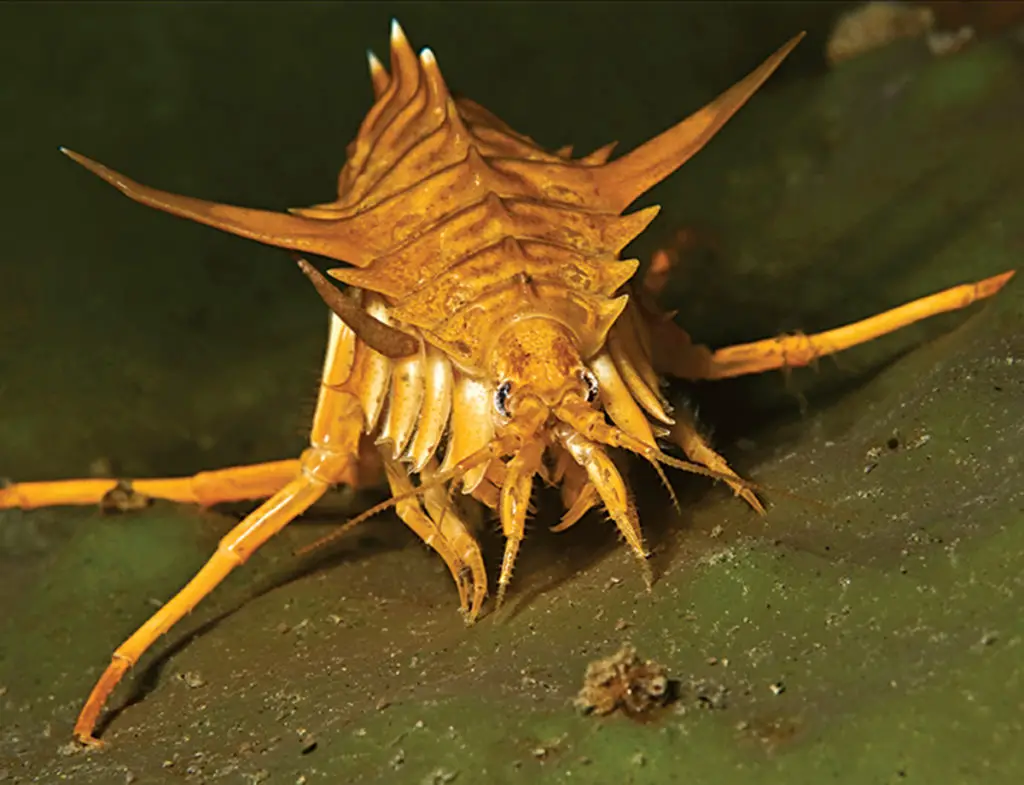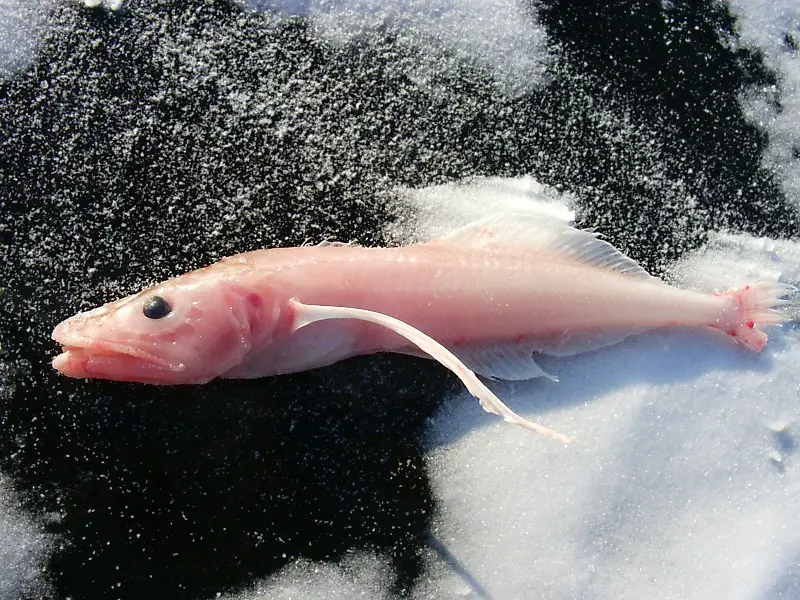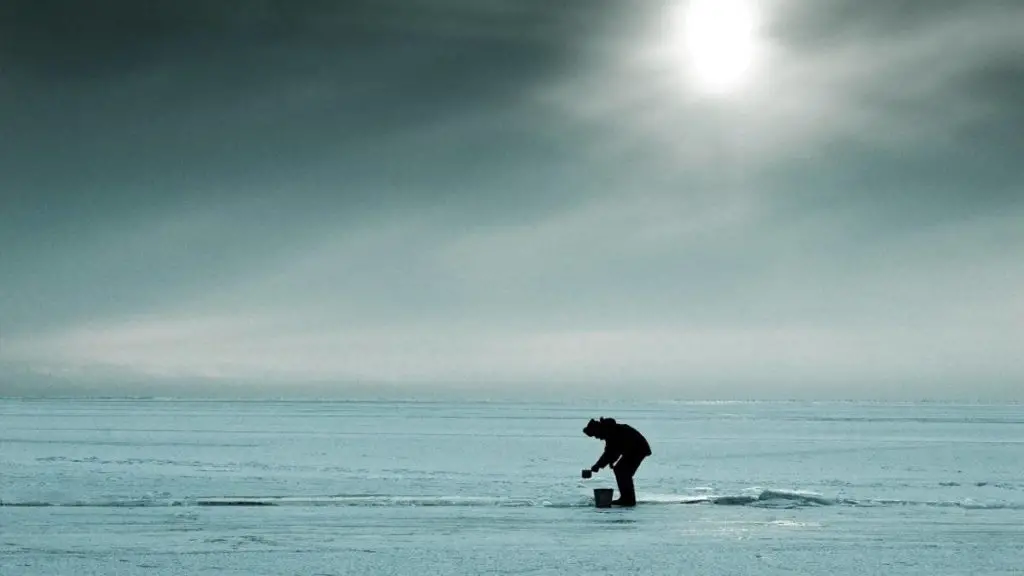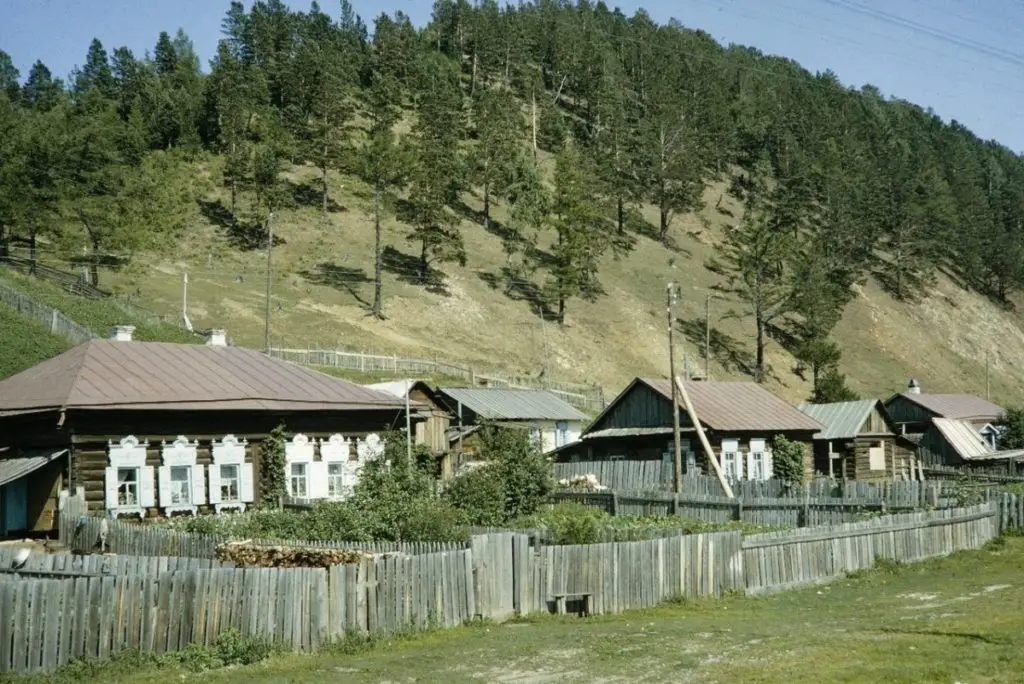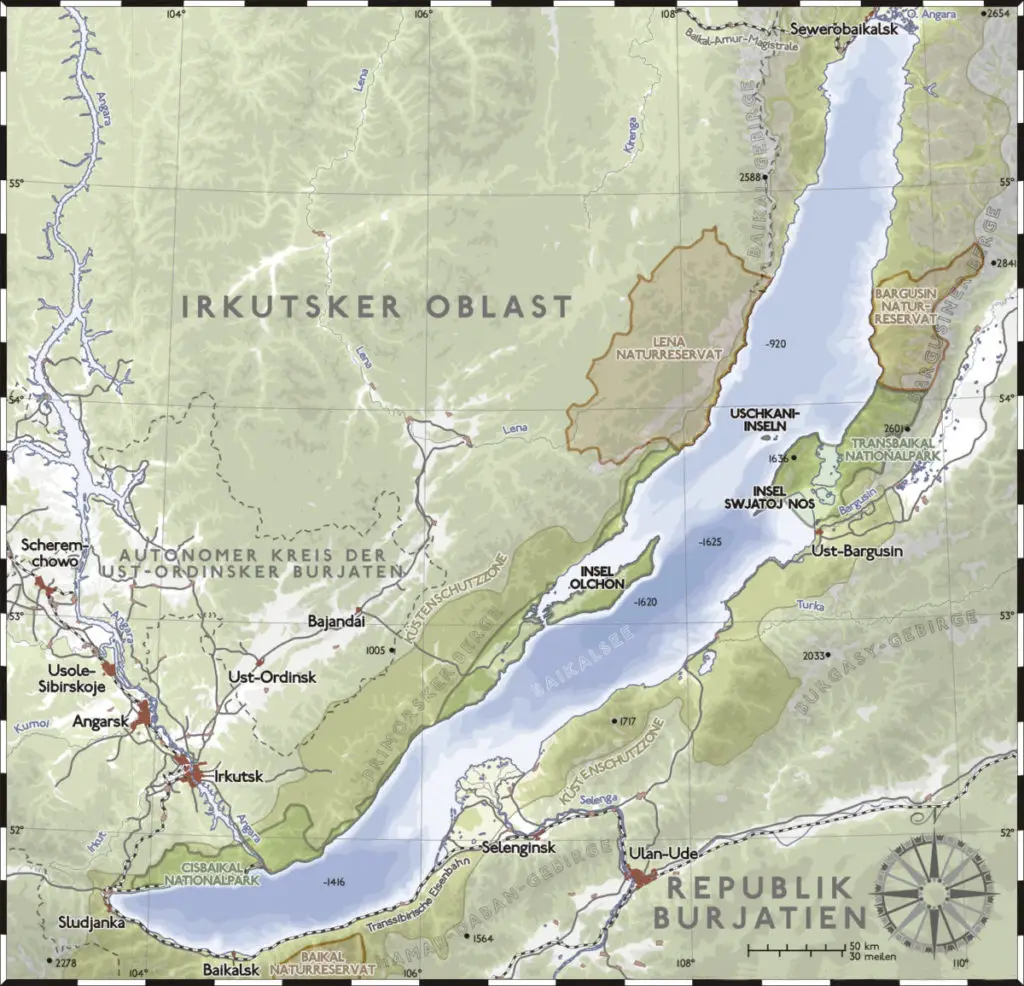Lake Baikal is one of the oldest lakes in the world, over 25 million years old, with a number of features that make it both beautiful and mysterious. With a depth of 1,680 metres, imagine what it can hold in its depths. We invite you to learn all about this mysterious and exciting ecosystem.
Indice De Contenido
Origin of Lake Baikal
Lake Baikal has a tectonic origin, due to the movement of the rocks that make up the underground layers of the Earth, this movement is caused by the forces and energies that converge in the interior of our planet. These forces are capable of moving these plates, creating mountain ranges and the environment for ocean basins to form.
Geologists speculate that a northward moving sub-continent collided with Asia and the impact of the colliding plates created huge chunks of rock that formed what we know today as the Himalayas.
This collision between the two continents activated the deep layers of the Siberian region, one of which is identified as the Baikal Trench. Over time, mountain streams deposited more than 7 kilometres of sediment in the trench, which then filled with water to form this lake.
Lake Baikal was created by these tectonic movements more than 25 million years ago, making it the oldest lake in the world. It is located in southern Siberia in Russia, specifically the Irkutsk Oblast to the northwest and the Republic of Buryatia to the southeast, near the city of Irkutsk.
It is important to note that an oblast is a form of republican organisation in Russia, with federal institutions that give the country an organisational status.
Getting back to our topic of interest, Lake Baikal’s name comes from the Tatar Bai-Kul, which means ‘rich lake’. This beautiful and unique place in the world is also known as the Pearl of Asia or the Blue Eye of Siberia.
The origin of Lake Baikal and its location, given by the action of nature and its incredible geomorphological processes, allow it to be part of a complex river system, which includes the Baikal-Selenka-Ider River, the fifth longest river in the world with a length of 5,539 km. This system also includes the Yenisei River, which rises in Tuva and flows along the Russian-Mongolian border into the Kara Sea.
Its ancestral origin gives Lake Baikal unique and unrepeatable characteristics in terms of water quality, biodiversity and more. It is an ecosystem of paramount importance, containing at least 20% of the world’s unfrozen freshwater, making it one of the largest water reserves on the planet. The very idea of the forces involved in the formation of this lake makes us think about the origin of the world.
Geological studies of the lake itself confirm that it was formed by the division of two faults, which were then uplifted by the mechanical energy generated by the geothermal energy of the magma, creating the concavity in which Lake Baikal emerges in a rugged manner, running some 600 km across Russia and so majestic that it can be seen from space.
The ruggedness of its geography also gives it the title of the world’s deepest lake, at 1,680 metres, its crystal clear waters in summer allowing you to see up to 50 metres down, and in the harsh, cold winters it becomes a mass of ice, making its waters a magical and changing place, remote and mysterious.
History of the world’s oldest lake
What we know today as Lake Baikal was known to the Chinese dynasties as the Great Southern Sea. It was the scene of violent battles for control of territories between the 2nd century BC and the 1st century AD.
The Xiongnu people, who were nomadic and roamed the eastern steppes freely, inhabited what is now Mongolian territory, and on their travels they encountered the settlers of the Han dynasty, who were seeking territorial expansion, which led to clashes that took place in the existing Lake Baikal region.
After this period, the shores of Lake Baikal were inhabited by Mongols, including the Yakuts, who are thought to have arrived in the area in the 10th and 12th centuries and settled in what is now Yakutia. The Buryats, also of Mongolian descent, also settled in the region and their descendants can be found in the area today.
Lake Baikal was discovered by Russian expeditions in the 17th century. The first westerner to reach the lake was Kurbat Ivanov in 1643 and he is regarded as one of the greatest explorers of Siberia.
Today, the Lake Baikal region remains a sparsely populated area of incipient development, the settlements that have developed are small, and communication with communities outside the lake area is by boat. There are only five developed urban areas, which may cause some problems for the integrity of the ecosystem, especially in terms of pollution.
As noted above, Lake Baikal is located in south-eastern Siberia, with the Irkutsk Oblast to the north-west and the Republic of Buryatia to the south-east, in the Russian Federation. As a result, its location gives it a high degree of political and administrative complexity.
Below we will describe in detail the basis for the political and administrative complexity, which is of course caused by the borders and location of the watershed that feeds Lake Baikal, which is shared between Russia and Mongolia, although Lake Baikal is entirely on Russian territory.
The Lake Baikal basin is home to three independent Russian states, one autonomous region and 25 Russian districts, as well as 12 Mongolian states and 116 Mongolian districts. In addition, there are more than 45 national parks, important cultural sites and extensive nature reserves in the basin, the maintenance and protection of which is shared by both states.
In addition, Lake Baikal is an ecosystem inhabited by unique species, with more than 300 rivers flowing into it, creating the largest freshwater reserve on the planet. These were some of the reasons why it was declared a World Heritage Site by the United Nations Educational, Scientific and Cultural Organisation (UNESCO) in 1996.
Rivers that flow into Lake Baikal
More than 500 rivers flow into Lake Baikal. One of the most important rivers is the Selenga, which provides more than 60% of the water entering the lake each year. There are important differences between the many rivers that make up the Lake Baikal basin, including their flow, length, size and other aspects.
Among the main rivers that flow into Lake Baikal, we can mention the Selenga, which, as already mentioned, is the largest and most important of its tributaries; there is also the Chikói, which flows through the central-southern part of Russian Siberia and is a tributary of the Selenga. The Khilok River, which belongs to the Yenisei basin, flows through Lake Baikal and the Angara River.
The next major tributary is the Uda River, which, like the Jilok River, belongs to the Lake Baikal basin and flows into the Yenisey. Then there is the 480 km long Barguzin River in eastern Siberia, which has an average discharge of 130 m³/s. The Turka River in eastern Siberia has an average length of 480 km. The Turka is fed by meltwater and the summer and autumn rains that occur in the area, so it is classified as a pluvial regime river.
To complete the list, the Sarma River, the Snézhnaya River and the Angará River flow from the southern end to the northern end of the lake, with its outlet in the south-eastern area and its mouth forming a delta of considerable size.
It is important to note that scientific studies carried out on this body of water indicate that in a short time the tributaries of Lake Baikal will cease to supply it with water, in fact it would take about 400 years for the lake to dry up, the only natural agent involved being the process of evaporation.
The amount of water entering Lake Baikal can supply it for 40 years without any problems of shortage. And as a final curious fact, it has been estimated that if Lake Baikal were to empty, it would take a year to fill it with the flow of all the world’s rivers flowing into its basin.
Characteristics of Lake Baikal
As we have already mentioned, one of the most important characteristics of Lake Baikal is its age, which exceeds 25 million years, as well as its depth, which is estimated at 1,620 metres, not to mention the fact that the layer of sediment at the bottom of the lake is more than 6,000 metres thick.
Continuing with the description of this great body of water, it has a surface area of 31,500 square kilometres, a width of more than 50 kilometres and a length of 636 kilometres. The volume of water contained in Lake Baikal is estimated to be more than 23,000 cubic kilometres.
The age of the lake has influenced the diversity of the flora and fauna that inhabit it, as well as contributing to the clarity of its waters, in which there are micro-organisms that contribute to its cleanliness.
In this respect, the Secchi disk is a tool to measure the turbidity of water bodies through light penetration, which can be caused by suspended sediments or by the amount of phytoplankton or zooplankton present.
In Lake Baikal, clarity values down to 50 metres have been recorded, which is an unusual feature compared to other similar bodies of water. It is this clarity that has given Lake Baikal the name “Blue Eye”.
https://www.youtube.com/watch?v=o9xA57mvP2E
The quality of its water is also extremely pure, with a relatively low salt content. In winter, when the lake freezes over, the ice can be up to three metres thick, but this does not prevent the rocks and part of the lake bed from being visible. This is also confirmed by the quality of its sediments, which have not been affected by continental glaciers.
If we look at the surroundings of Lake Baikal, we can see that it is completely surrounded by mountains, which is why the bottom of the lake has a large amount of sediment that is carried away by run-off water.
Calculations have been made that the amount of sediment accumulated is so great that if it were removed, the depth of the lake could be up to 9 kilometres deeper. Lake Baikal contains at least 22 islands, the largest being Oljon Island, which is 72 kilometres long.
Lake Baikal and its protected area
In order to preserve this incredible mountain ecosystem, the Baikal Nature Reserve was created 50 years ago. The reserve protects not only Lake Baikal, but also the entire central part of the Chamar-Daban mountain range.
The protected area covers 165,700 hectares. The biodiversity of this ecosystem is of global importance, as its antiquity has allowed the establishment of species of flora and fauna not found anywhere else in the world.
Scientific studies have identified impressive species; the reserve is home to more than 812 species of plants, more than 40 species of mammals, 7 species of fish, 272 species of birds, as well as insects, reptiles and amphibians of scientific importance.
The Baikal Nature Reserve is part of the World Network of Biosphere Reserves, which aims to protect natural areas and ecosystems on land, sea and lake, and to serve as an example of how people should live in harmony with nature. Lake Baikal is also a World Heritage Site.
A total of 12,100 hectares of the Kabanski Nature Reserve, which includes a research station in the heart of the Selenga River delta, were transferred to the Lake Baikal Nature Reserve to preserve this beautiful place.
Flora, Fauna and geology
Understanding biodiversity is one of the most important goals of biology, but despite great efforts, we are still far from knowing exactly how many species inhabit the planet. However, one of the greatest obstacles to this goal is the unfortunate loss of species as a result of human intervention and modification of the environment.
Lake Baikal, as we have said, is an important reservoir of endemic species that must be preserved. The number of species living in this lake, which do not exist anywhere else in the world, is 848.
One of the most studied endemic species in its habitat is the Baikal seal, whose scientific name is Pusa sibirica and which is the only freshwater seal in the world, as well as the Baikal sturgeon and the golomyanka fish, the latter being a viviparous fish that finds its habitat in the depths of the lake.
The most striking feature is that it is a translucent fish that gives off iridescent glitter when it is at a depth of 1,000 metres, and the epishura crab is responsible for filtering the water of Lake Baikal.
This tiny crustacean plays an extremely important role as it is very abundant and forms an essential part of the lake’s food chain. It is estimated that there are more than 3 million epishura per square metre of surface area.
The sponge forests that grow in Lake Baikal make the bottom of the lake a whole ecosystem to explore. Like marine coral, the green sponges grow and branch out into the depths, providing food and shelter for countless species. The dynamic balance of Lake Baikal is extremely fragile.
Another species of great importance is the omul fish, whose exquisite white flesh makes it highly desirable to locals. The lake is also home to one of the strangest animals ever seen, a single-celled worm-like organism about 30 centimetres long that feeds on fish.
The lake is also inhabited by other single-celled organisms that move on the sand, such as some aquatic worms that feed on plankton and other fish. A curious inhabitant of these waters is the golomianka, an albino fish native to Lake Baikal, which can be seen in the following picture.
There is still a lot to study and know about Lake Baikal, but thanks to the progress of science there is hope to know more about it, and in this sense molecular tools are one of the best research tools, as they allow to study the origin and evolution of the biodiversity of complex aquatic systems.
On the other hand, molecular markers and new theoretical and statistical models to analyse them help to reveal patterns and processes about the biodiversity, phylogeography and evolution of the organisms that inhabit this system.
Knowledge about microorganisms would help to understand the complexity and functionality of aquatic microbial communities, the link between populations and much more, which would of course be of great help for the conservation of the flora and fauna inhabiting Lake Baikal. The importance of understanding the dynamics of aquatic environments is based on the fact that they contain the greatest biodiversity on the planet.
The geology of Lake Baikal is very interesting and unique because, unlike other lake systems, this body of water is growing over time. Its location between active tectonic faults means that it has an annual growth rate of at least 2 centimetres. This causes numerous earthquakes due to the constant movement of the tectonic plates, but this lake can hold more water each year.
The constant movement of the plates means that there are thermal waters, creating habitats for plant and animal species associated with the high temperatures. Unlike other lakes, Lake Baikal does not silt up, and the geological explanation is that the crack widens, so instead of reducing its length and depth, it increases.
Climate of the lake
The climate in the area where Lake Baikal is located is actually extreme, there are five months of the year when the lake is covered by a layer of ice that can last until the end of January. When all the ice on the lake breaks up and melts and the water is clear by the end of April, it stays that way until June.
The climate is cold and temperate. Winter is considered dry, as there is much less rain than in summer. The average annual temperature is 0.1°C and the average rainfall is 512 mm, with February being the driest month with 9 mm of rain, while the wettest month is July with an average of 118 mm, which is also the warmest month of the year with an average temperature of 18.2°C. January is the coldest month of the year. January is the coldest month of the year with an average temperature of -20.0°C.
Depth of Lake Baikal
The depth of Lake Baikal was unknown to the scientific world until 2008, when a group of scientists managed to see the depth of the lake. At that time, a yellow silt was observed at a depth of 584 metres.
The maximum depth recorded so far is 1,680 metres, but as the bottom of the lake is not flat, it is possible that there are places of greater depth that have not yet been explored.
The largest and purest freshwater reservoir in the world
Lake Baikal is considered to be the largest, cleanest and most important freshwater reservoir in the world. Its waters are known not only for their transparency, but also for their high oxygen content.
This is due to the presence of vertical and horizontal currents that enrich the mixture of water columns with oxygen. The size of Lake Baikal and its depth mean that this body of water contains 20% of the world’s pure freshwater, i.e. one fifth of the world’s freshwater.
The coastal town of Listvyanka
The town of Listvyanka belongs to the Siberian district, specifically the Altai region. It has a population of 1,834, according to the last census conducted in the region in 2010.
It is a beautiful urban settlement in the Irkutsk Oblast, easily accessible by bus or ferry from the capital, and over time has become one of the most important tourist destinations in the region, being a beautiful seaside resort on the shores of Lake Baikal.
It was founded in 1773 as a post station. The town of Listvianka is very popular with tourists and has seen significant hotel development. It is a popular destination for people travelling to Lake Baikal. Near the town is the Talzy open-air museum, which displays wooden buildings typical of 19th-century Siberia.
The beautiful town of Listvyanka lies at the source of the Angara River. To visit it, drive from Irkutsk; the road always follows the banks of the Angara and you’ll see beautiful birch forests, making it a worthwhile trip from start to finish. There are plenty of places to stay and eat in the city.
Map of Lake Baikal
At the end of this tour of the magnificent Lake Baikal, we will show you a map where you can see the exact location of the lake, as well as heights, depths, locations and boundaries of this marvellous place.
If you enjoyed this article, we invite you to continue learning about the world’s lake ecosystems by clicking on the links below:
- Kama River
- Ems River
- Paraná River

